
 |
|
|
|
#1 |
|
Guest
Posts: n/a
|
Thought id put this up as a helpful reference to channafanatics.
 Information is edited by me ( english typo error ) Credits go to Plausible and Tropheus of MFK. Scientific name: Channa Mircopeltes Common name: giant snakehead , toman snakehead , red snakehead , redline snakehead maximum size: reports upto 5ft or 152cm - these until proven otherwise are to be discredited as fishermens tales the average size recorded is around 3.5ft or 106cm but in home aquaria a very large specamin would be around 3ft or 91cm , which is still a lot of responsability for any owner/keeper native range : thailand , malay peninsula , sumartra and borneo introduced range: USA including - Maine , Massachusetts , Rhode Island ,Baltimore, Los Angeles , several captures throughout Florida temperament: one of the few social channa species ,its known to hang out and hunt in groups , in the aquaria they do well in groups when they are still youngsters but soon they'll start squabling amoung each other as transformation takes place to an adult, however many people have succesfully housed a group together into adulthood , temperament between the micropeltes and other fish good when young but as the fish grow they tend to become more aggresive , and any addition to the already established tank is usually killed swiftly , strangly fish that have grew up with the micropeltes are sometimes ignored and accepted as part of the group ,but if this fish is anything it is unpredictable ,and it would be foolish to house anything you are attatched to or indeed is expensive with this fish Temperature: the temperature range of this fish is from upper sub-tropical to tropical and is best maintained at around 25-30deg Breeding: no reports from private breeders although comercial breeding is frequent , clears an area of vegetation at the surface where the eggs are deposited and subsequently hatch out as fry . Parents guard and protect these eggs , only the very largest of aquaria would be possible to breed such a monster fish Habitat: rivers lakes canals and reservoirs ,usually found in still waters, unlike some of the dwarfs this species is thought to very rarley if at all leave the water and try to move across land Feeding: this is a very unfussy feeder , but stomach samples have shown that this fish mostly feeds on other fish , other contents where mainly frogs and birds , in the aquarium the fish will take all the usual fair. From frozen foods to livefoods. Mixing: should only be mixed with others from an early age and even then with extreame caution , do not keep anything with this fish that you will be upset by if you lost it , due to the final size of this fish most hobbiests will only have room for this fish alone when adult ,so mixing should not really be a concern Set-Up: Though they are big and mean , they still need to feel comfortable in their suroundings , create a set up with floating cover and heavy planting and wood use , these fish will thank you for it by being much more active and curious , as adults this type of set up may not be acheivable for most people due to the size of there aquaria , this is one of the reason this species is not really suited for the home aquaria , if you are to keep them as a bare minimun you should use floating cover as this will help settle the fish and reduce the hazzard of the fish breaking through the lid of the aquariam Why you should not keep: because this fish is capable of reaching 2.5 to 3 ft in the home aquarium needs a tank of at least 3ft wide and at least 8ft long , how many people do you know with that size tank ,even more so , how many people with that sized tank are willing to dedicate it to one fish (yes one fish ,this is the minimum size for one micropeltes to feel at least a little bit of security in) micropeltis are very fragile when in their young stages , they do not tolerate fluctuations in water parameters very well and many are lost to both beginers and more advanced aquarists micropeltes at a large size are dangerous , you wouldnt want to stick your bare hands in the tank for long periods of time. Why you should keep: because you have reached the next level and have in place a tropical pond in place ready for them as they grow , because you are one of the lucky few who have a tank big enough to house it for life , because you are lucky enough to live in the natural range where you can safely release them when they out grow there quarters, because they are the top freshwater predator , and are a fascintating fish to grow and study. Notes: Probably the most available snakehead on the market , most shops will either stock theese or have them on there order lists , extremly cheap to buy , used as feeder fish in asia 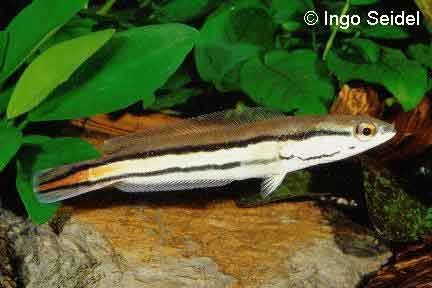  Pictures credited to Ingo Seidel |
|
|
#2 |
|
Guest
Posts: n/a
|
Scientific name: Channa Bleheri
Common names: Rainbow snakehead Size: Usually 15cm/6 inches Description: Described in 1991 by Heiko Bleher. One of the smallest and also one of the prettiest Snakeheads. No pelvic fins. Dorsal ray count 36-37; anal ray count 24; predorsal scales 6-7; lateral line scales 45-46 Juvenile differences in colouration: From a small size the sides of the body are yellow, with a dark bar on the head, angled from the tip of the lower jaw, through the eye. This then develops into adult colouration as the fish grows. Sexual Differences: Males are more brightly coloured and larger, males also grow quicker than females. Geographical location: Brahmaputra River basin, Northern Assam, India Maintenance: Snakeheads are known to live and survive in quite inhospitable conditions naturally so water quality is not paramount, but this doesn’t mean its ideal. Because of their high protein diet ample filtration is required and regular weekly water changes are best. Snakeheads do not cope with rapid water parameter changes as well as some other fish I.E a large PH change so its best to try and match the water as best as possible. Compatibility: One of the most peaceful Snakeheads, Territorial disputes can occur with other Snakeheads but it is rarely serious. Can be kept with other fish as long as they are not small enough to fit in their mouths. Hazard scale: Not considered to be hazardous in anyway. Water Parameters: Coming from the Assam region Channa Bleheri have a Winter temp of 19 C and Summer temp of 22-28 C/72-82 F; they prefer the cooler side of that range, pH 6-7.5, Tank size: One of the advantages of Channa Bleheri is its small size and peacefulness. These Snakeheads can be kept in a relatively small aquarium. 36” for a pair, groups can be kept in larger setups. Aquarium setup: The aquarium should be well planted with open areas to swim in. Make sure hiding places are provided. All Snakeheads breath air and can suffocate if they are prevented from reaching the surface to breath. A secure top should be in place as they are excellent jumpers. Channa Bleheri are excellent escape artists and can escape from the very smallest of holes. Do not underestimate their escaping abilities. They can survive for sometime out of water as long as their lungs don’t dry out but the impact from the height of the tank to the floor may cause injury they cannot recover from. Behaviour: These are one of the most peaceful snakeheads although territorial disputes can occur. It is possible to keep a number of these snakeheads in a relatively small aquaria. Breeding: These snakeheads have been breed many times in captivity. As with many snakeheads from the Northern Assam region it is necessary to lower the water temperature for a period of time then raise it to stimulate breeding. As with all snakeheads putting a male and female together is no guarantee that a pair will be formed. The best practice is to get a group and let a pair form from that group and then separate them as if breeding is successful the others will eat the fry. They should be provided with a cave which will make them feel comfortable and spawning will start from there. The male will select the site and the female will start the spawning, This will continue for a couple of days before the eggs are laid. The eggs are deposited and then float to the surface then collect as a floating raft. Hatching can take as little as 30 hours. They will be guarded by both parents and supplied with feeder eggs initially. They should be provided with small brine shrimp, and other small live food to begin with but they will quickly adapt of frozen and artificial foods Feeding: Accepts most meaty foods, Mussels, Shrimps and artificial foods. Misc. Information: This snakehead is commonly referred to as the Rainbow Snakehead, common names can be confusing and their use can cause issues with correct identification. There is also another snakehead sometimes referred to as Blue Bleheri, for some time it was thought that they may have been the same species, They are now described separately and named Channa Sp. Assam. Notes: used to be very common site in lfs , not so much now ,pattern and colour vary greatly between two fish ,and colourfull ones are getting harder to find , a fair few shops will have this fish on order lists. 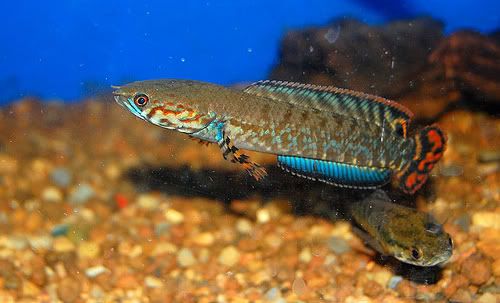 Pictures credited to Hayath |
|
|
#3 |
|
Guest
Posts: n/a
|
Scientific name: Channa Gachua
Common name: Dwarf snakehead , Brown snakehead , Frog snakehead Size: as a species complex the size of gachua is highly variable ,from around 7" to around 12" usually Temperature: As a species complex the range in indeed far and wide, upper range is 36deg in some hot springs in sri-lanka to 13deg in parts of Afganistan , it is therefore important to try and find out the origin country of your fish , as this lets you set up the aquarium to the best possable situation for your fish. Prefered PH: varies between where fish is found , it is know to tolerate from 3.1ph to 9.6ph with 100% survival , for best results aim toward neutral or slighly lower between 6-7ph Natural range: wide spead accross India ,Sri-Lanka ,Thailand , Xambodia ,Laos ,Bangladesh, Afganistan ,Iran ,Myanmar, Malaysia ,Borneo ,Vietnam ,Afganistan and China Introduced range: Taiwan and the Greater Suda islands Prefered habitat: pools, shollow river and streams Breeding: as with all the members of the channa group, its best to start out with a group of 6 or more fish , from this a pair should form ,when a pair has formed it is advisable to swiftly remove all other fish from the aquarium , gachua are mouthbrooders in the male sex ,and take excellent care of their young , one a a very few channa that will breed in tanks without plant cover , breeding is triggered by long periods without water change then a large change with fresh cooler water to initiate a spawning response. Sexing: sexing gachua is very hard and the only reliable way to get a pair is by letting the fish pair up from a group Tank set-up: even though this species can breed in a bare tank , its best to use a well structered tank with plant wood and rocks and floating cover as this fish can be very shy and if it does not feel secure it will spend most of its day hiding. Feeding: feeding in the aquarium is simple and the fish will happly consume all the normal foods used from frozen fish food to fresh shrimp ,prawns and even pellets , it is important not to overfeed this fish as they can quickly become over weight ,every other day is enough and you may find you can cut back to once every 3 days , in nature they are nocturnal feeders. Their stomach contents reveal a diet of rats , fish, tadpoles, prawns ,crabs ,and other crustaceans Temperament: very sociable channa, outside of breeding they are quite happy to live along side each other ,and rarely bother other fish ,however if a pair forms in the aquarium aggression level will raise drastically Mixing: mixes quite well with other fish as long as its basic needs are catered for , avoid overly aggresive fish and fish small enough to be seen as food , fish that have been tried and tested include angles, rainbow fish and some of the more docile cichlids , please bare in mind that if you keep this fish with other the chance of breeding will be greatly reduced as the gachua sometimes see the other tank inhabitants as a threat and the fries are swiftly eaten by other tank mates , avoid useing plecos that are easy to breed because if they breed the channa will eat the babies and their bristles can get stuck in the channas mouth . Also try and reserch where your fish has come from ,the gachua from China and Afganistan would not do well in full tropical temperatures Notes: the easiest dwarf channa to find in shops , a lot of the more specalised shops will carry these ,and nearly all shops will have them on there order lists.  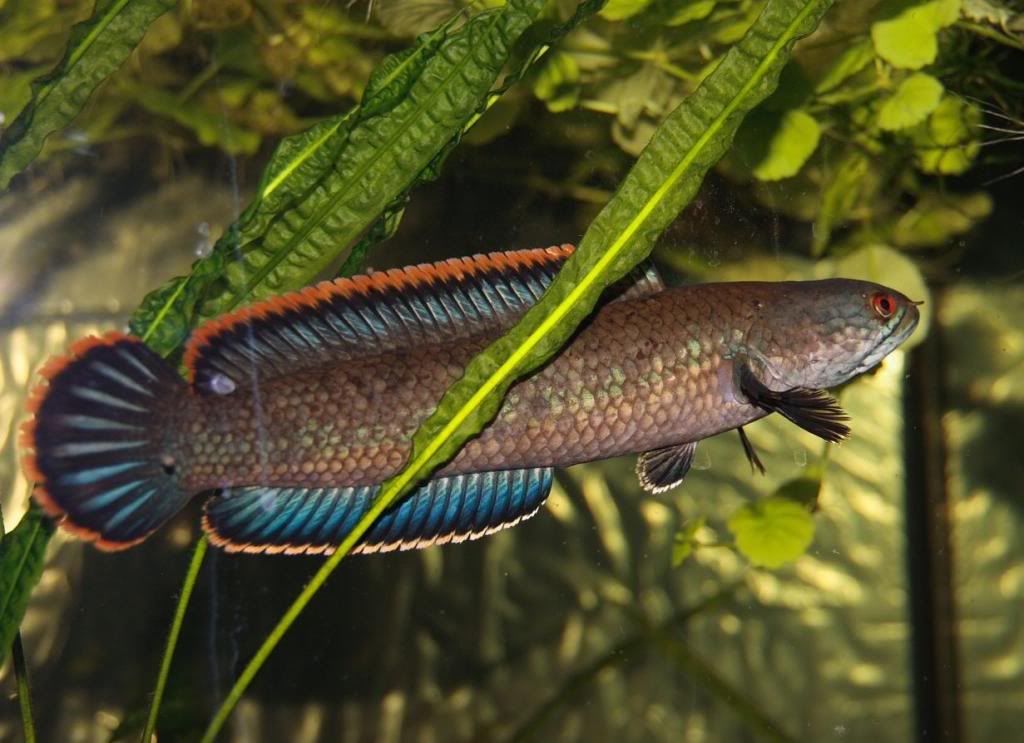 Pictures are from Google at Channa Gachua. |
|
|
#4 |
|
Guest
Posts: n/a
|
Scientific name: Channa Aurantimaculata
Common name : Golden spotted cobra snakehead , Orange spotted snakehead Size: upto around 16 inches or around 40 cm Temperature: 19deg in winter and up to 25deg in summer Prefered PH: between 6 and 7ph but know to tolerate a wide range Natural range: Brahmaputra River basin, Northern Assam, India - same area as bleheri and sp turqoise Habitat: ponds, swamps and streams etc Introduced range : none known at this time Breeding : only known breeding sucess is reported by a german aquarist , from this we know they are mouthbrooders and also egg feeders , practice spawning can be witnessed year round but activity heightens as temperatures drop during winter. We believe the trigger temperature to be around 20deg , as with all channa its best to start out with a group and let the fish pair up for themselves . Sexing: it is very dificult to tell the sexes apart ,but there are some pointers that will help with this , females have less spots / freckles and wider more defined orange bars , females' heads are more rounded when looking from a profile shot male has more sloped head. Tank set-up: floating cover is a must for this species as they like to hang out under it , also a cave of some description is prefered ,without a cave they usually dig into the substrate to try and burrow, tank should be well structured with plants and wood ,to enable less dominant fish an escape route. Sand substrate is preferred and they have been know to eat small pebbles rocks etc which most of the time they throw up but they may get stuck and cause problems. Like most sub-tropicals from India they seem to prefer the addition of powerheads near the surface during winter, which can be removed around april in time for summer Tank size: even though this is a medium sized channa keeping any more than one requires a very long tank ,otherwise fights will break out constantly and will often result in the death of any of the fish , i would advise 7ft or longer for a pair of group , single fish kept as a specimen can be housed in smaller quarters Feeding: all the usual foodstuffs are taken ,but seem to show a preference for prawn, shrimp,small cuts of fish, etc but are quite happy with most frozen foods and can be trained to eat pellets but when eating pellets they are very messy so having an excellent filtration system is a must. Temperament: towards there own kind they are among one of the nastiest channa around. They simply cannot stand each other unless they have formed a pair, even then fights can break out at the drop of a hat and they are capable of inflicting great damage on each other, strangly when mixed with other fish they seem to ignore all but the smallest fish ,if they dont see it as food they are usually fine. Mixing: firstly these fish are best kept as a pair ,a bonded pair and as the availability of true bonded pairs is nearly non existent and if they do come up the prices would reflect this. So it is best to keep in a species tank in the hope to get a pair from the group. You should have no problem in moving on any fish you end up with extra as they are always on demand, if keeping a bonded pair of group is not for you , this species can be housed with other fish, but choose carefully robust fish that are not overly aggresive, as these fish are sub-tropical you need to house with fish that will tolerate the lowest end of the tropical range, i would not suggest keeping long term at temperatures above 24-25deg, keeping in mind this fish does need floating cover to feel secure it is probably best to also avoid fish that eat plants. Notes: one of the most in demand of all the channa and low availability means that this fish comands a high price even at small sizes. If the channa ban goes ahead in 2010 with lack of tank bred specimens, prices will no doubt sore , and in time could be lost from the trade , it is impotant for any owner to try to breed there aurantimaculatas to keep this fish in the trade 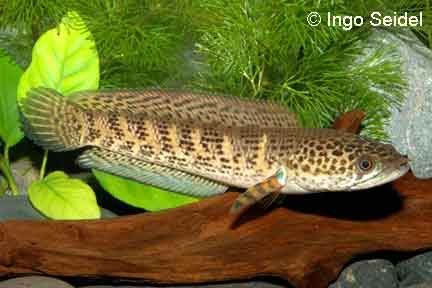 Picture credited to Ingo Seidel |
|
|
#5 |
|
Guest
Posts: n/a
|
Species name: Channa marulius complex
Common name: Great snakehead, Bullseye Snakehead, Indian snakehead, "Pla Chon" Maximum size: 180 cm / 70 inches is noted as largest specimen but belived to be uncomfirmed , the largest confirmed at present is belived to be 122cm or 48 inches , in the home aquarium finding a specimen over 90cm or 36 inches would be exceptional , it is noted as one of the fastest growing snakeheads about equal with micropeltes , average growth is around 7cm per month , and starts to fill out in the second year Origin :Pakistan India, Sri Lanka, Bangladesh, Southern Nepal , Myanmar, Thailand, Mekong basin of Laos , Cambodia, and Southern China Introduced range: Tamarac, Broward County, Florida, Temperament: being a species compex the temperament varies widely , from moderately aggressive to very aggresive depending on location Company: being a species complex this is always going to be hit and miss ,i advice you use extreme caution , we have known some i.e. pseudomarulia to be very peaceful whereas others will not tolerate a single fish in the aquarium with them. Also its important to try and find out where your fish was caught , some of this complex are temperate to sub-tropical and some are tropical so any tankmates would need to suit these requirements, it is also noted that at a size of 25cm+ this species becomes a lot more aggresive toward anything housed with it Water parameters: Temperature range is very wide ,this species ranges from temperate to tropical regions , lowest known temp is 10 c. Again finding out the region your fish is from will help provide the best transition from wild to captive pH 6-7.5 Feeding: It is predatory species its prefered food is 60% other fish and 40% crustations , in the aquarium it will take all the usual things . Breeding: this is going to be beyond all but the most dedicated aquarist sine the size of aquarium that would be required to acheive this will be beyond most peoples budgets. As with other members of the group ,start out with a small group of 5-6 fish , the fish will choose there own partner ,at which time any other fish should be quickly removed from the aquarium. Breeding can happen throughout the year , the pair will build a nest out of vegetation where they will deposit their floating eggs, the eggs hatch in around 30-50 hours depending on the temperature of the water. The higher the temperature the quicker they hatch. Parents guard the fry up until around 10cm and any maintanance in the aquarium should be kept to a bare minimun at this stage. The young can be fed newly hatched brineshrimp and shortly after finely chooped other foods. Brood sizes are reported from 400 to 3700 Aquarium : the length of this fish is to be taken into account when choosing an aquarium. It can and does reach 3ft in an aquarium setting so the minimun width should therefore be 3ft, with a length of around 9ft being a bare minimun. The aquarium should be set up with sand as the substrate ,and floating cover an important feature , caves and large roots to hide under will be greatly appreciated. Notes: there are many pictures around the internet of this fish when they are young, however pictures of this fish in adult stages in home aquaria are very few. Which would suggest that most people do not realise the full extent of what they are taking on when buying this fish and most in the trade sadly do not reach adulthood. This is probably the second most common snakehead offered for sale ,and prices should be low. 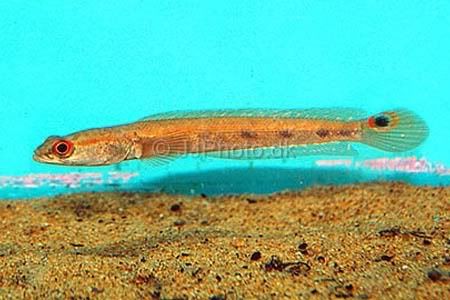 A picture of the young 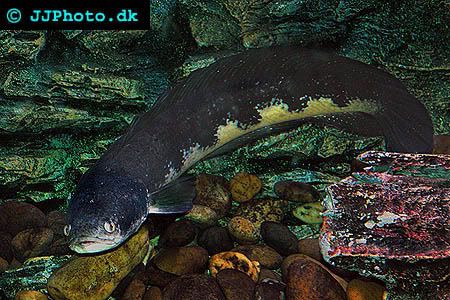 A picture of the adult Pictures credited to JJ photos. |
|
|
#6 |
|
Guest
Posts: n/a
|
Scientific name: Channa Asiatica
Common name: Chinese Snakehead, Green snakehead Maximum size: 34 cm / 14 inches , growth is rapid in the 1st two years then slows very much thereafter Origin: China, middle and lower Chang Jiang (Yangtze) basin, and Xun River basin in Guangxi and Guangdong provinces introduced range: Taiwan ,Japan, Ishigaki Shima Island in the Ryukyu Islands and occasionally found in Florida - USA Temperament: Very Aggressive to others and there own kind , this is among the most aggresive snakeheads , often removal of one of the fish is needed after spawning to prevent the partners killing each other , this fish does not take any prisioners and victims often appear to have been skinned. Company: very rarely accepts company in the long term and company should be sub-tropical which excludes most aquarium fish , should be kept in species tank , even bonded pairs have been known to kill each other Water parameters: Temperature 18-24c another sub tropical species pH 6-7.5 Feeding: thrust preditor, feeds on other fish crustations and small mammals, in the aquarium can be trained to accept all the common offered Breeding : as always start out with small group and allow the fish to choose a pair , once paired remove all other fish from the aquarium , floating cover should be used in the aquarium, breeding starts at around 18 deg, eggs will float to the surface where they are guarded by parents ,eggs hatch out in around 48 hours depending on tempretue ,the higher the tempreture the quicker they hatch, new born should be fed with newly hatch brine shrimp, then offered finely crushed foods as they grow. Aquarium: well structured tank with plants wood etc is recommended. It is important that they have lots of escape routes. Due to their aggresive nature i would not recomend any tank smaller than 4 foot long by 20 inches by 20 inches , yet a bigger tank is much better for them , floating cover should be used and if breeding ensure that the water is still at the surface as eggs float to surface . Notes: this fish is found in the trade from time to time , it is fairly rare to find in lfs or on order lists , to find this fish you will probably need to contact a specalist shop or breeder direct. 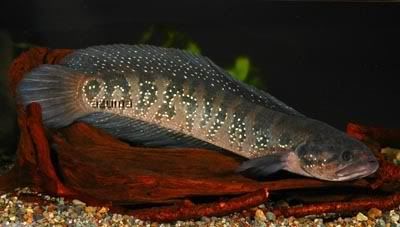 Picture's from Google at Channa Asiatica |
|
|
#7 |
|
Guest
Posts: n/a
|
Scientific name: Channa Striata
Common name: Chevron Snakehead, Striped Snakehead, Haruan ,Toman Paya Maximum size: 90 cm / 35 inches Origin: Pakistan, most drainages of India, Southern Nepal, Sri Lanka, Bangladesh, Myanmar, Thailand, Cambodia, Southern China, Malay Archipelago Introduced range: Hawaii ,Madagascar( theese are suspected mis-identifacation of maculata) , Philippines, Vogelkop Peninsula, Papua, Indonesia, Sundaland, Sulawesi, Lesser Sundas, Moluccas, Mauritius, Southern China. Temperament: striata is another suspected complex and so aggression levels vary between location , although in general most straitas are aggresive and grumpy fish that do not tolerate other very well at all Company: often passed off as a tropical species the complex ranges through temperate to tropical areas , to ensure best care try and find out from where your fish has come from so you can choose temperatue and company to suit , straita is often considered one of the hardest species of channa to mix with other fish tank: due to the size and aggresiveness of this fish only the largest of home aquaria should be considered , if keeping more than one in a tank a lot of cover at surface and structures to break the line of sight between the fish should be used Water parameters: Temperature 16-28˚C another wide ranging complex that covers areas that are from temperate to tropical , try and verify where your fish has been imported from pH 6-7.5 Feeding: main food in nature is frogs worms prawns but most of all other fish. It will accept all living food that is appropriate for their size in aquaria can be trained to eat dead foodstuff. Fries feed on algae. Breeding: acheived in aquarium , eggs float to the surface where guarded by both parents ,some time deposited in floating vegitation but know without any vegitation , can breed twice a year and all year round , parents can be canabalistic on fry if food is in shortage and fry can be canabalistic amoung each other , find a pair through the normal channa way of starting with a small group of 6-8 juviniles and let pair off note: can be found in the trade from time to time but fairly rare , its importance as a source of food means it stays fairly rare for most in the trade, when available they are relativly cheap to purchase , most albino strains of snakehead are straita ,the albino strain will comand a higher price than the standard pattern. 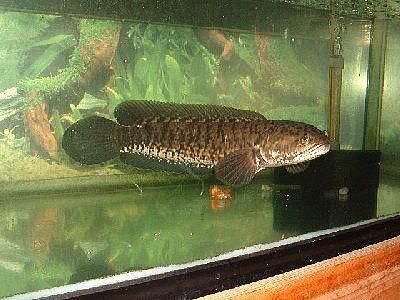 Picture's from Google at ChannaStriata. |
|
|
#8 |
|
Guest
Posts: n/a
|
Scientific name: Channa Stewartii
Common name: Golden Snakehead Assamese snakehead Maximum size: 30cm approx 11inches although varients reported larger Origin: Endemic to Brahmaputra (upper, middle, lower) River basin of India and Bangladesh, Ganges River basin from southern Nepal southeastward . In southern Nepal, it occurs in the Kamala, Bagmati, Koshi, Gandaki, and Karnali River basins Introduced range : not known at this point Temperament: often sited as one of the more aggresive snakeheads ,they belong to the same group as aurantimaculata and barca and have the same sort of temperament, Company: as a sub-tropical species tankmates should be chosen to suit , if this fish takes a dislike to any tankmate it will swiftly kill them , even its own kind are not tolerated very well ,and this fish is probably best left to the more experianced channa keeper in a well though out species tank Water parameters: Temperature 18-24c ranges from warm temperate to sub-tropical ; pH 6-7.5 Feeding: this snakehead will accept all the usual fare , feeds well on insects worms ,frozen foods, market shrimp and prawn also bits of fish Breeding: start out with small group and allow them to chose there own pair , this fish is mouthbrooder in the male sex , they are very good parents and fry should be left with parent until upto 10cm in lenght Tank: even though this is a dwarf species you can not get away with a small tank , in small tanks they will fight constantly and that will result in many deaths , as always floating cover is needed to feel secure and the tank should contain many hiding places and be well planted , this is another species that really does prefer older tank water and live plant will help keep nitrates under control in such tanks aswell as providing much needed cover and hiding spots for the fish and breaking up the line of sight Notes: this fish is offered from time to time in the more specialised stores and from time to time on order lists , although they have become harder to obtain in recent years , because of the colouring of this fish and the relative small size ,especially of some of the newer varients ,this fish often comands a high price. 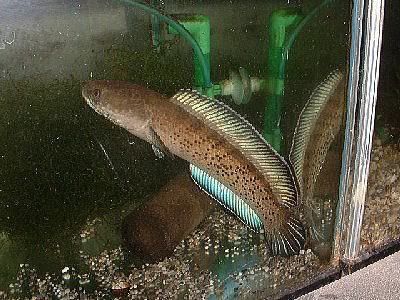 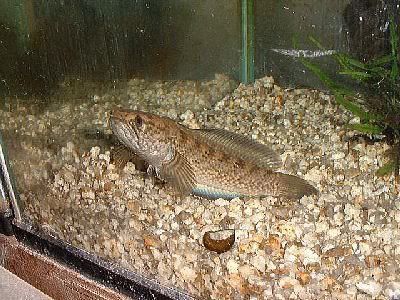 Pictures are from Google at ChannaStewerti |
|
|
#9 |
|
Guest
Posts: n/a
|
Scientific name: Channa Marulioides
Common name: Emperor Snakehead, Darkfin snakehead, Toman Bunga, Flower snakehead ,Blue snakehead ,Blueline snakehead ,Green snakehead , Sumatran cobra snakehead Maximum size: 65 cm / 26 inches Origin: Rivers of southeastern Sumatra, Kapuas basin of western Kalimantan , Bangka, Belitung , Samarinda, eastern Kalimantan, peninsular Malaysia, Pahang , southern Thailand Introduced range: none confirmed at this time allthough unconfirmed reports are comming out of Florida USA Temperament: this channa is very rarely aggresive towards other fish or its own kind outside of breeding time , it is often said to be one of the more passive snakeheads. Company: this fish is a fairly good candadate for mixing with other fish ,so long that its requirments are met , you need to bare in mind that this fish alone will need a huge tank as an adult ,and when young it can be bullied by more aggresive fish. It will eat smaller fish given the opportunity, but looking at its teeth structure would suggest that it eats more crustations ect in nature and its lack of aggresion against other fish also goes to suggest this Water parameters: Temperature ,found in tropical areas 22-28˚C / 72-82˚ F; pH 6-7.5 it is though that lower ph and softer water have a direct influence on the development of the flower patterns that develop along the flanks of this fish , many in the aquarium do not fully develop these ,as of this time no scientific test have been carried out Feeding: Will like most other snakeheads eat almost any meaty food you give them or can be trained to do so. but do show a preference for prawns, shrimps etc it will also eagerly accept worms insects ect breeding : breeding has only been acomplished a couple of times in the aquarium both by the same person , it is reported to spawn in november and on both occasions spawned on exactly the same day of the month in november , we know from this that floating eggs are produced and are procected by a raft made out of vegetation that the parents make , at this time the parents become very aggresive and will attack anything in or near the tank , they also aggresive to each other and you may need to seperate them , for obvious reasons breeding should anly be attempted in a huge tank that is very well though out tank: this is a very large fish and req's a very large tank to suit , i would not recomend any thing less than 7ft long and 3ft wide , height is not so important , the tank should be very well thought out , even though they are big fish they still need hiding places and floating cover is a must as they like to hang out at the surface , tropical tempretures should be maintained notes : these are quite often found ,and are usually not very expensive , they come up quite oftem on order lists and can be found in some of the more specalist shops choose fish with six or more dark bands along there flanks , seven bands are seen as the best and have the most potential of becoming fully patterned adults , five bands are the most commonly found 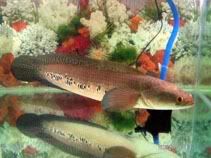 Picture's from Google at Channa Marulioides |
|
|
#10 |
|
Guest
Posts: n/a
|
Scientific name: Channa Barca
Common name: Barca Snakehead Maximum size: up to 35" or 89cm Origin: Brahmaputra river near Goyalpara , the Ganges , from India and Bangladesh Introduced range: none known at this time Temperament: reported as very aggresive to its own kind and others , said to share the same temprement of other channa most closley related .i.e aurantimaculata and stewarti Company: has been mixed with other fish ,but great caution is advised ,this fish would be best at home living in a bonded pair. Anyone lucky enough to own one or several should do there most to try and breed this very rare fish. Water parameters: another sub-tropical species , the area of the brahmaputra river system that this fish is found ,does experience near tropical temps during the hot season and can get fairly cold in the cooler season , i would suggest setting your heater at 16-18deg as a low point and letting ambient temperatures take care of the warmer temps , if you live in an area that is cold year round where the tank is situated slowly raise your tempreture to 24-25deg throughout the summer months , water in the brahmaputra river is genrally soft to neutral ,samples taken show nitrate levels vary between 0 and 35ppm Habitat preference: inhabits larger rivers ,and is found in holes in the bank of the river ,the hole are not thought to be dug by the fish but rarther by either local birds or crabs , the hole genrally go upto a couple of feet into the bank and end in a round area ,where useally two fish can be found laying in a circle like a wheel , it is though the fish sits with its head poking out of the hole in the riverbank waiting for fish and other food to swim past where it can strike and then retreat back into its hole where it can eat its prey in safety Reproductive habits: unknown , the way this fish lives in the wild will certainly make it dificult to reproduce the conditions needed for reproduction in the home aquaria , but never the less with enough creativity anything it possable , anyone who manages it will have the honor of being the first person to acheive this and would no doubt make a lot of money from it , channa barca is without doubt one of the most expensive freshwater fish in the trade , and by far the most expensive channa ,at least until channa amphibious is re-descovered aquarium: a very large fish at the 3ft mark so a relativly large aquarium is also a must , they live in a riverbank so that is what you need to think about when aquascaping your tank , some sort of cave as a bare minimun but with a bit of creative flair anything is possable , the vast majority of channa requires floating vegetation to breed ,i would add this as it generally helps calm the fish down and feel secure also other information: remains the single most sought after channa available in the hobby, there is still only a few in captivity , pairs being even rarer with only one confirmed pair and another pair rumoured to exist. The price of this fish varies greatly depending on supply and demand. 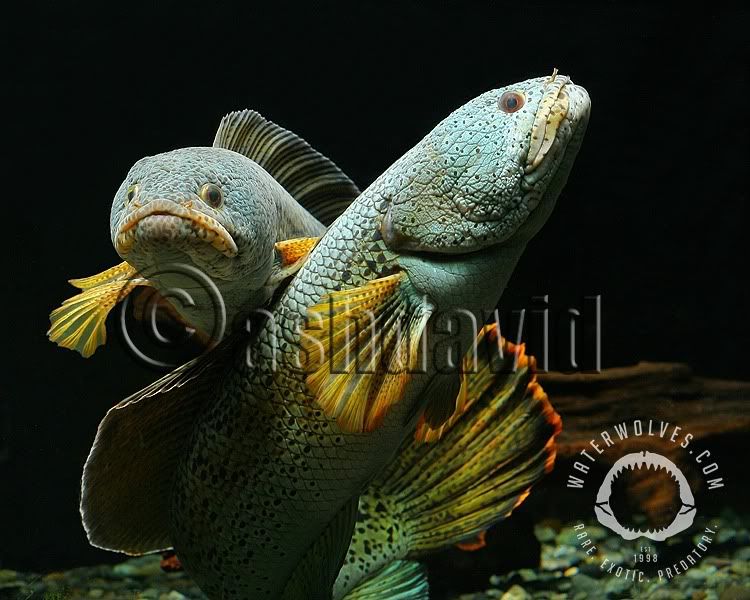 Picture credited to AshDavid of Waterwolves |
 |
|
| Currently Active Users Viewing This Thread: 1 (0 members and 1 guests) | |
|
|